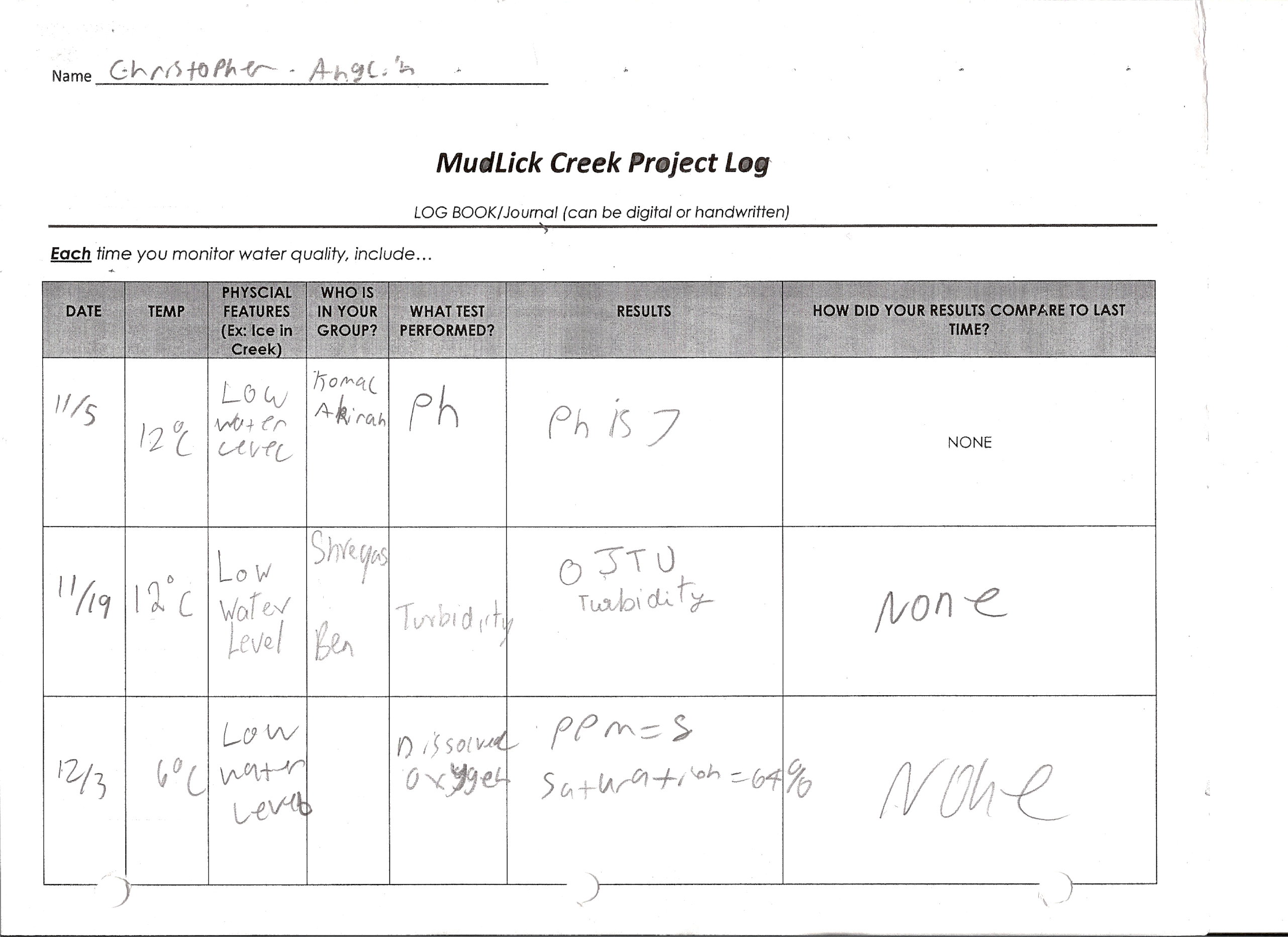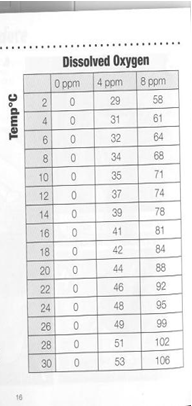Abstract
Due to the increased instances of freshwater pollution in many American water sources particularly through agricultural and industrial wastes, which are discharged into the water, students were asked to monitor the quality of water at the Mud Lick creek (I think the statement now makes sense as you had requested). During these investigative sessions, the students collected data regarding the dissolved oxygen, pH, turbidity, and the temperature of water samples collected from the creek. The average value of the water temperature at the creek ranges from 6-12°C.
Furthermore, the average value of turbidity ranges from 0-40 JTU relative to different experiment days. Moreover, the average pH value equals 7.25 for the three trials conducted over the whole experiment duration. Lastly, the average value of dissolved oxygen ranges from 4-8 parts per million and the saturation percentage is in the range of 55-64%.
The experimental findings provided above show that the level of freshwater pollution at the creek is irregular because the results show slight changes from the normal properties of freshwater particularly the pH, dissolved oxygen, and its turbidity.
On the other hand, the study findings diverge from most studies reviewed in this research paper particularly those regarding the quality of water in many American water sources.
As a result, additional studies are required to ascertain the accuracy and precision involved in the current study including determining additional parameters, which can enable one to measure the quality of water at the creek more accurately.
[The information given in this section shows the writer’s stand regarding the experimental findings relative to other study findings reviewed in this research paper. Besides, the statement is drawn from the discussions provided in the conclusion]
Introduction
Freshwater pollution entails instances whereby the sources of inland water are contaminated through the presence of various substances in water, which make it unsafe for various uses (Saunders 16). As a result, most studies show that pollution may occur through the discharge of fecal matter, chemical substances, pesticides, petroleum components, fertilizer sediments, and other discharges into freshwater thereby making it unfit for fishing, swimming and drinking.
For instance, in the United States, various studies note that fecal matter and other potential pollutants are discharged into rivers, and therefore, there is evidence of freshwater pollution in most American streams and rivers.
According to Pollution Issues (par. 1), “In the mid-twentieth century, many American rivers and streams were open sewers, choking on everything from human waste to highly toxic industrial discharges.”
Furthermore, fresh water sources contribute to about 3% of the total water sources on the earth’s surface. However, in the United States, each household consumes about 94,000 gallons of fresh water per annum. Moreover, the sources of the fresh water for domestic use include rivers and lakes.
Unfortunately, studies conducted in 2000 show that about 40% of rivers and 45% of lakes in the United States are polluted with pesticides and fertilizers due to runoffs (Pollution Issues par. 13). This form of pollution poses great danger to human beings because the contents of the runoffs include phosphates, pathogens, petroleum oils, gasoline, and other pollutants.
Conversely, various human activities are attributable to freshwater pollution in different aspects. For example, the increased number of households connected to sewerage treatment systems has been associated with freshwater pollution in most OECD-member countries (OECD 100).
Moreover, OECD (101) states that, “Agriculture is an important contributor to water quality problems, particularly nitrate pollution in surface and groundwater, phosphorus levels in surface water, contamination with pesticides, and the harmful effects of soil sediments and mineral salts.”
At the Mud Lick creek under investigation, there is evidence of agricultural activities on the upper side of the tributary. This potential source of pollutants poses significant risks to the quality of water at the creek in terms altering the temperature, pH, dissolved oxygen, and the turbidity of the water (Pollution Issues par. 3). As a result, there is the paramount need to investigate the water quality at the Mud Lick creek in this research paper.
This research paper aims at determining the water quality at the Mud Lick creek relative to various qualitative and quantitative parameters such as temperature, pH, turbidity, and dissolved oxygen. Here, it is hypothesized that the water temperature will be in the range of 12-24°C relative to different experimental conditions and days.
Moreover, the pH of the water is hypothesized to range from neutral to slightly alkaline. On the other hand, the value of turbidity is hypothesized to range from 0-42 JTU due to different agricultural activities and pollutant discharge rates at the creek. Lastly, the level of dissolved oxygen is hypothesized to vary relative to the temperature of the water samples.
Overall, the findings regarding the present survey seem to diverge from the current studies on freshwater pollution in many American rivers and Streams. [The information provided in this section serves as the thesis statement, which is explained in detail in the subsequent paragraphs. As a result, there is no need to cite the information because it entails a personal account regarding the experiment]
Methods and Materials
The investigation of the quality of water at the creek entails measuring the temperature, pH, turbidity, and the dissolved oxygen. Each of these parameters requires different procedures and Test Kits. For instance, to determine the turbidity of water, one requires a sample collection jar, a Secchi disk, and a color chart (World Health Organization 68). Here, a white sample collection jar is used to carry out the experiment.
The first step entails removing the icon sticker from the Secchi disk. Secondly, place the sticker slightly off center on the inner bottom side of the sample collection jar 8-24 hours prior to the commencement of the experiment. This process ensures that the adhesive cures adequately.
Thirdly, fill the jar with water up to the turbidity level indicated by a label. Lastly, hold the turbidity chart against the jar containing water in order to compare the appearance of the disk icon to that on the chart (World Water Monitoring Day 8-10). Subsequently, record the value in JTU in a table of results.
Conversely, to determine the pH of the water samples, one needs to have a pH test tube, a pH reagent tablet, and a pH color chart (World Health Organization 67).
As a result, the first step in measuring the pH value involves filling the pH test tube with 10 ml of the water sample. Secondly, one piece of the pH test tablet is added into the test tube. Thirdly, the test-tube is sealed and the contents mixed by inverting the tube until the tablet dissolves.
Lastly, hold the test tube against the pH chart and compare the color of the test-tube contents to the one on the chart (World Water Monitoring Day 17). Record the pH value in the table of results as shown in the tables below.
7th Period –Mud lick Creek Project Log. All items below are averages of all groups:
Furthermore, to determine the value of dissolved oxygen in a water sample, the experimenter requires one measuring vial, test tablets, and a color chart (World Health Organization 51).
Here, the first step involves recording the temperature value of the water samples. Secondly, the vial is submerged and filled to the top with a sample of water whose temperature has been determined. Thirdly, two test tablets are added into the vial. Subsequently, the vial is capped and the contents mixed by inverting the vial severally for four minutes.
Afterwards, the vial is left to stand for an additional five minutes in order to allow for color development. Lastly, the vial is held against the color chart to compare the color in the vial with the one on the chart (World Water Monitoring Day 13-15). The results are recorded in a table of results in parts per million.
Furthermore, the % saturation is determined from the % saturation chart. It is worth noting that the current experiment was performed three times on different days and the average values for temperature, turbidity, pH, and dissolved oxygen were recorded in tables.
Results
The results obtained in the present experiment were recorded in the form of tables. From these tables it is notable that the average value for temperature lies in the range of 6-12°C for the three trials conducted. Furthermore, the average value for turbidity ranges from 0-40 JTU relative to different experiment days.
Moreover, the average pH value is 7.25 for the three trials. Lastly, the average value for dissolved oxygen (DO) ranges from 4-8 ppm and the saturation percentage is in the range of 55-64%. Here, the value of % saturation is determined by comparing the value of dissolved oxygen in parts per million against the water temperature on the % saturation chart shown in the table below.

Conclusions
Relative to the findings of the experiment described above, it is obvious that the quality of water varies with different industrial, agricultural and human activities around water bodies (Saunders 16). As a result, the study findings show that the level of freshwater water pollution at the creek is irregular and limited to low levels of pollutants.
For instance, the value of turbidity is zero for most experimental trials except for one trial, which shows an increase in the value of turbidity. Furthermore, the findings show that there are minimal levels of thermal pollution at the creek since the temperature values recorded are relatively low. As a result, there is evidence of high levels of dissolved oxygen, which can support both aquatic and terrestrial life forms.
According to World Water Monitoring Day (11), “Aquatic animals are sensitive to changes in water temperature and require a certain temperature range to survive and thrive….Temperature also affects the amount of oxygen water can hold.”
Therefore, the low temperature value for water at the creek contributes to a smaller % saturation value, which reflects a higher dissolved oxygen value as provided in the World Water Monitoring Day (13) whereby the author posits that, “water at 28°C will be 100% saturated with 8 ppm dissolved oxygen. However, water at 8°C can hold up to 12 ppm of oxygen before it is 100% saturated.”
On the other hand, the pH value of the water at the creek is slightly basic, and thus, there is evidence of low levels of fertilizer or industrial pollutants in the water (World Health Organization 67-69).
Unfortunately, there are no statistical studies regarding the quality of water at the Mud Lick creek, which will allow one to make appropriate comparisons. However, different studies note that many American fresh water sources are polluted with different substances contrary to the findings of the current study.
Therefore, there is the paramount need for additional studies, which should aim at carrying out random sampling of water from the Mud Lick creek to confirm or down play the findings of the present study. Overall, the experiment was successfully conducted because most of the hypotheses stated earlier are acceptable relative to the study findings.
Works Cited
OECD. OECD environment outlook. Paris, France: OECD Publications Services, 2001. Print.
Pollution Issues. Water pollution: freshwater. Advameg, Inc., 2010. Web.
Saunders, John Williams. The estimation of pollution damage. Manchester: Manchester University Press, 1976. Print.
World Health Organization. Guidelines for drinking water-water quality. 2nd ed. Malta: World Health Organization Publications, 1997. Print.
World Water Monitoring Day. Test kits. WEF-IWA, 2009. Web.